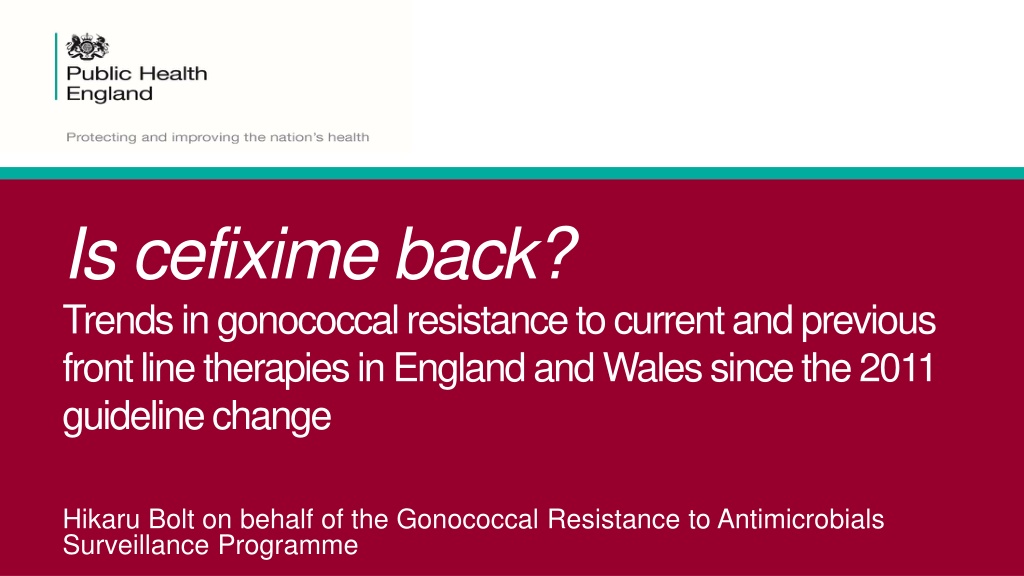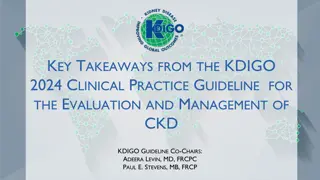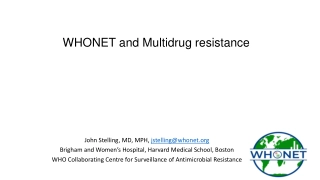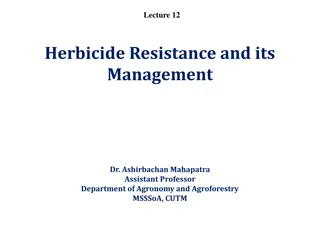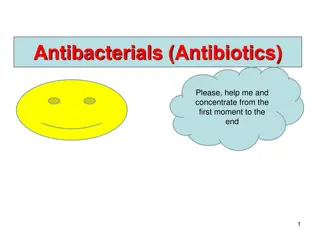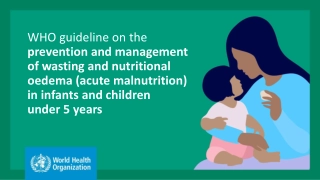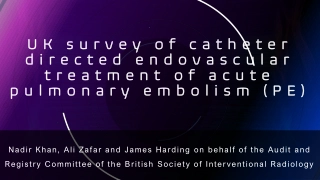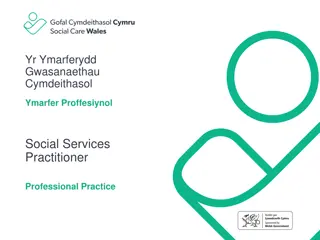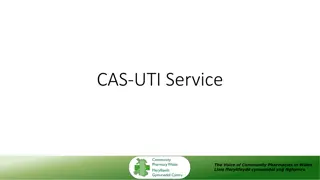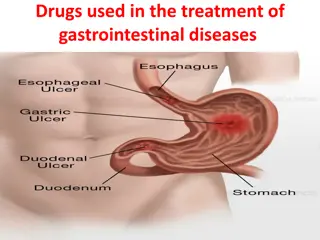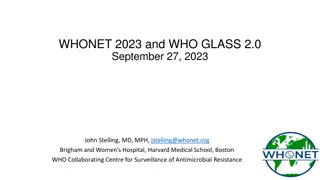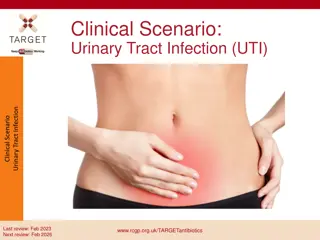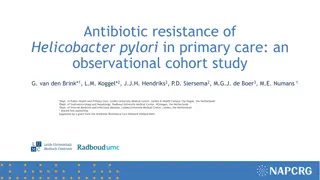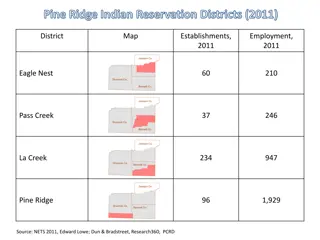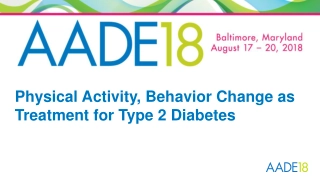Trends in Gonococcal Resistance to Therapies in England and Wales Since 2011 Guideline Change
Antimicrobial resistance in Neisseria gonorrhoeae poses challenges for treatment. This study examines trends in ceftriaxone, azithromycin, and cefixime resistance since the 2011 guideline change in the UK. Data from the Gonococcal Resistance to Antimicrobial Surveillance Programme is analyzed to track resistance levels over time.
Download Presentation
Please find below an Image/Link to download the presentation.
The content on the website is provided AS IS for your information and personal use only. It may not be sold, licensed, or shared on other websites without obtaining consent from the author. Download presentation by click this link. If you encounter any issues during the download, it is possible that the publisher has removed the file from their server.
Presentation Transcript
Is cefixime back? Trends in gonococcal resistance to current and previous front line therapies in England and Wales since the 2011 guideline change Hikaru Bolt on behalf of the Gonococcal Resistance to Antimicrobials Surveillance Programme
Introduction Antimicrobial resistance (AMR) in Neisseria gonorrhoeae threatens effective treatment and infection control WHO recommends that treatment guidelines for gonorrhoea are revised when the prevalence of resistance to first-line therapy exceeds 5% In the UK in 2011, guidelines changed from a cephalosporin monotherapy (predominantly cefixime) to dual therapy using ceftriaxone and azithromycin We aim to describe the trends of ceftriaxone, azithromycin and cefixime resistance since the 2011 guideline change using data from the Gonococcal Resistance to Antimicrobial Surveillance Programme Trends in gonococcal resistance to current and previous front line therapies in England and Wales since the 2011 guideline change 2
Methods GRASP (Gonococcal Resistance to Antimicrobials Surveillance Programme) is a sentinel surveillance programme Collects N. gonorrhoeae isolates from 27 genitourinary medicine clinics in England and Wales between July and September Represents ~5.5% of reported episodes of gonorrhoea in England Minimum inhibitory concentration of seven antimicrobials linked to detailed demographic, clinical and behavioural data Analysed data between 2011 and 2014, including 6001 isolates Trends in gonococcal resistance to current and previous front line therapies in England and Wales since the 2011 guideline change 3
Ceftriaxone resistance (0.125mg/L) MIC (mg/L) distribution over time Isolates less sensitive 55 50 45 2011 2014 KS Test p < 0.001 Percentage of Cases 40 35 30 25 20 15 10 5 0 .002 .004 .008 .015 .03 .06 .125 2011 2013 2012 2014 Trends in gonococcal resistance to current and previous front line therapies in England and Wales since the 2011 guideline change 4
Azithromycin resistance (1.0mg/L) MIC (mg/L) distribution over time Isolates less sensitive 45 40 35 Percentage of Cases 2011 2014 KS Test p < 0.001 30 25 20 15 10 5 0 .002 .004 .125 .25 .5 1 2 3 4 8 16 256 2011 2013 2012 2014 Trends in gonococcal resistance to current and previous front line therapies in England and Wales since the 2011 guideline change 5
Cefixime resistance (0.125mg/L) trend data 40 40 40 40 40 40 40 40 40 Guideline change 35 35 35 35 35 35 35 35 35 30 30 30 30 30 30 30 30 30 Percentage Resistant Percentage Resistant Percentage Resistant Percentage Resistant Percentage Resistant Percentage Resistant Percentage Resistant Percentage Resistant Percentage Resistant 25 25 25 25 25 25 25 25 25 Test for Trend p < 0.001 20 20 20 20 20 20 20 20 20 15 15 15 15 15 15 15 15 15 10 10 10 10 10 10 10 10 10 5 5 5 5 5 5 5 5 5 0 0 0 0 0 0 0 0 0 2006 2006 2006 2006 2006 2006 2006 2006 2006 2007 2007 2007 2007 2007 2007 2007 2007 2007 2008 2008 2008 2008 2008 2008 2008 2008 2008 2009 2009 2009 2009 2009 2009 2009 2009 2009 2010 2010 2010 2010 2010 2010 2010 2010 2011 2011 2011 2011 2011 2011 2011 2011 2011 2012 2012 2012 2012 2012 2012 2012 2012 2012 2013 2013 2013 2013 2013 2013 2013 2013 2013 2014 2014 2014 2014 2014 2014 2014 2014 2014 2010 Year Year Year Year Year Year Year Year Year Parameter estimate Parameter estimate Parameter estimate Parameter estimate Parameter estimate Parameter estimate Parameter estimate Parameter estimate Heterosexual men Parameter estimate Parameter estimate Parameter estimate Parameter estimate Parameter estimate Parameter estimate Parameter estimate Parameter estimate MSM Women Trends in gonococcal resistance to current and previous front line therapies in England and Wales since the 2011 guideline change 6
Cefixime resistance (0.125mg/L) MIC (mg/L) distribution over time Isolates less sensitive 50 45 2011 40 Percentage of Cases 2014 KS Test p < 0.001 35 30 25 20 15 10 5 0 .002 .004 .008 .015 .03 .06 .125 .25 2011 2013 2012 2014 Trends in gonococcal resistance to current and previous front line therapies in England and Wales since the 2011 guideline change 7
Cefixime resistance (0.125mg/L) MIC (mg/L) distribution by gender and male sexual orientation in 2014 50 40 Percentage of Cases 30 20 10 0 .002 .004 .008 .015 .03 .06 .125 Heterosexual men Women MSM Trends in gonococcal resistance to current and previous front line therapies in England and Wales since the 2011 guideline change 8
Percentage of gonococcal isolates resistant to cefixime ( 0.125mg/L) by ceftriaxone MIC (mg/L): 2011-2014 100 90 80 Percentage of Cases 70 60 50 40 30 20 10 0 .002 .004 .008 .015 .03 .06 .125 Cefixime sensitive Cefixime resistant Trends in gonococcal resistance to current and previous front line therapies in England and Wales since the 2011 guideline change 9
Discussion is cefixime back? Ceftriaxone use may be contributing to cefixime drift Ongoing dissemination of N. gonorrhoeae with elevated cefixime MICs in MSM Cefixime resistant isolates tend to have higher ceftriaxone MICs Ceftriaxone resistance remains rare Evidence suggests cefixime is not back Trends in gonococcal resistance to current and previous front line therapies in England and Wales since the 2011 guideline change 10
References Cole, M. J., et al. (2015). "Is the tide turning again for cephalosporin resistance in Neisseria gonorrhoeae in Europe? Results from the 2013 European surveillance." BMC Infect Dis 15: 321. Ison, C. A., et al. (2013). "Decreased susceptibility to cephalosporins among gonococci: data from the Gonococcal Resistance to Antimicrobials Surveillance Programme (GRASP) in England and Wales, 2007-2011." Lancet Infect Dis 13(9): 762-768. Public Health England. (2015). GRASP 2014 Report. Trends in gonococcal resistance to current and previous front line therapies in England and Wales since the 2011 guideline change 11
Acknowledgements All collaborating GUM clinics and staff for the submission of the additional data through the web portal All collaborating laboratories for sending the isolates the STBRU GRASP Steering Group GRASP team at PHE Trends in gonococcal resistance to current and previous front line therapies in England and Wales since the 2011 guideline change 12
